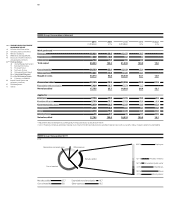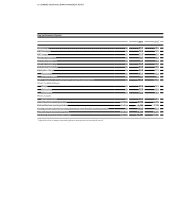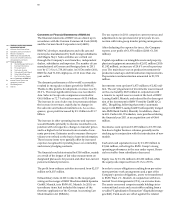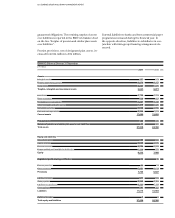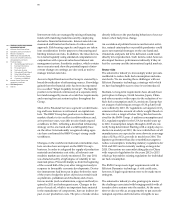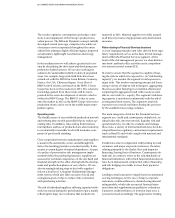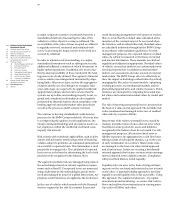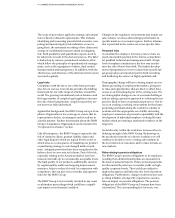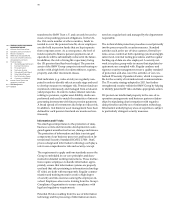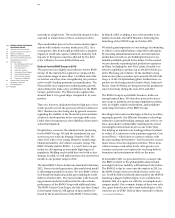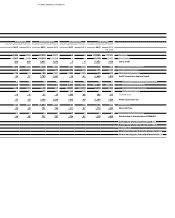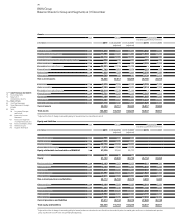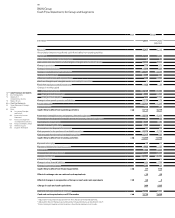BMW 2011 Annual Report Download - page 70
Download and view the complete annual report
Please find page 70 of the 2011 BMW annual report below. You can navigate through the pages in the report by either clicking on the pages listed below, or by using the keyword search tool below to find specific information within the annual report.
70
18 COMBINED GROUP AND COMPANY
MANAGEMENT REPORT
18 A Review of the Financial Year
20 General Economic Environment
24 Review of Operations
43 BMW Stock and Capital Market
46 Disclosures relevant for takeovers
and explanatory comments
49 Financial Analysis
49 Internal Management System
51 Earnings Performance
53 Financial Position
56 Net Assets Position
59 Subsequent Events Report
59 Value Added Statement
61 Key Performance Figures
62 Comments on BMW AG
66 Internal Control System and
explanatory comments
67 Risk Management
73 Outlook
to major corporate customers is primarily based on a
standardised method of measuring the value of the
vehicle(s) or other object(s) serving as collateral. The
recoverability of the value of items accepted as collateral
is regularly reviewed, measured and evaluated with
a view to assessing the impact on the level of risk not
covered by collateral.
In order to minimise risk from lending, we employ
standardised instruments such as subsequent security,
additional collateral, retention of vehicle documents or
higher upfront payments. In addition, the levels of au-
thority and responsibility of those involved in the lend-
ing process are clearly defined. The segment’s financial
services entities are managed and monitored by stipu-
lating limits. All process steps, such as the segregation
of duties and the use of techniques to recognise risks
at an early stage, are required to be applied worldwide.
Appropriate testing is carried out to ensure that the
systems are up to date and working properly. Local, re-
gional and centralised credit audits are also regularly
performed by Internal Audit to check compliance with
lending approval and authorisation rules procedures
as well as the processes and IT systems involved.
We continue to develop standardised credit decision
processes for the BMW Group worldwide. The focus here
is on improving the quality of credit applications, the
Group’s rating methodology and procedures used to se-
lect employees within the worldwide credit and coun-
terparty risk network.
Risk criteria with worldwide applicability, such as debt
arrears, bad debt ratios and the proportion of financing
volumes subject to problems, are calculated and analysed
on a monthly or quarterly basis. This information is used
proactively to manage risks. The calculation of expected
losses serves as the basis for determining the level of risk
provision to be recognised in the balance sheet.
The segment’s portfolio risks are managed using state-of-
the-art techniques based on relevant regulatory
require-
ments such as Basel II. Unexpected losses are measured
using credit-value-at-risk methodologies and are moni-
tored and managed by means of a global limit system. Ap-
propriate control measures are applied as the need arises.
In the case of vehicles which remain with the Financial
Services segment at the end of a contract (leases and
credit financing arrangements with option of return),
there is a risk that the residual value calculated at the
inception of the contract may not be recovered when
the vehicle is sold (residual value risk). Residual values
are calculated uniformly throughout the BMW Group
in accordance with mandatory guidelines. For risk
management purposes, the expected risk-free residual
value of a vehicle is measured on the basis of external
and internal information. These amounts are checked
regularly and adjusted as appropriate. Residual values
of vehicles on used car markets are continuously moni-
tored and reported on. In addition to internal infor-
mation, our assessments also take account of external
market data. The BMW Group strives to effectively re-
duce the impact of declining residual values by actively
managing the life cycles of current models, optimising
reselling processes on international markets and im-
plementing targeted price and volume measures. Poten-
tial losses are measured by comparing forecasted mar-
ket values and contractual residual values by model and
market.
The risk of incurring unexpected losses is measured on
the basis of a value-at-risk approach. The portfolio risk
is also monitored and managed in the case of residual
value risks by a system of limits.
Interest-rate risks relate to potential losses caused by
changes in market interest rates and can arise when
fixed interest-rate periods for assets and liabilities
recognised in the balance sheet do not match. For risk
management purposes, all interest-related asset or
liability exposures are aggregated on a cash flow basis,
taking account of subsequent changes, e.g. in the case
of early termination of a contract. Interest-rate risks
are
managed on the basis of a value-at-risk approach
and a limit system. Limits are set using a benchmark-
oriented approach that focuses on interest-rates arrange-
ments contained in the original contracts. Compliance
with prescribed limits is tested regularly.
Liquidity risks can arise in the form of rising refinanc-
ing costs on the one hand and restricted access to funds
on the other. A matched funding approach is used stra-
tegically
to avoid liquidity risks as far as possible. Using
this approach, the segment endeavours – by regular
measurement and monitoring – to ensure that cash in-
flows and outflows from transactions in varying matu-
rity cycles will offset each other.


